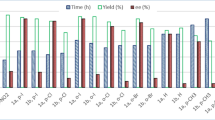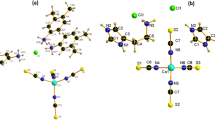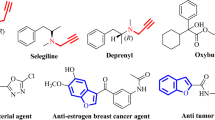Abstract
ANHYDROUS bis(salicylaldehydato)copper(II) and bis(8-hydroxyquinolinato)copper(II) were obtained by precipitation of the complexes from aqueous solution and recrys-tallization from water-free chloroform and chlorobenzene respectively. Both compounds formed bronze-green crystals. Their structures have been determined from single-crystal X-ray photographs using copper kα-radiation. Both compounds were found to crystallize in the monoclinic space group P21/c, details being as follows:
This is a preview of subscription content, access via your institution
Access options
Subscribe to this journal
Receive 51 print issues and online access
$199.00 per year
only $3.90 per issue
Buy this article
- Purchase on SpringerLink
- Instant access to full article PDF
Prices may be subject to local taxes which are calculated during checkout
Similar content being viewed by others
References
Stackelberg, M., Z. Anorg. Chem., 253, 136 (1947).
Koyama, H., Saito, Y., and Kuroya, H., J. Inst. Polytech., Osaka, 4, C, 43 (1953).
Frasson, E., Bardi, R., and Bezzi, S., Acta Cryst., 12, 201 (1959).
Barclay, G. A. (private communication).
Hall, D., and Waters, T. N., J. Chem. Soc., 2644 (1960).
Graddon, D. P., and Watton, E. C., J. Inorg. Nucl. Chem., 21, 49 (1961).
Author information
Authors and Affiliations
Rights and permissions
About this article
Cite this article
BEVAN, J., GRADDON, D. & McCONNELL, J. Crystal Structures of Bis-(Salicylaldehydato)-copper(II) and Bis-(8-Hydroxyquinolinato)-copper(II). Nature 199, 373 (1963). https://doi.org/10.1038/199373a0
Issue date:
DOI: https://doi.org/10.1038/199373a0
This article is cited by
-
Tumor cellular proteasome inhibition and growth suppression by 8-hydroxyquinoline and clioquinol requires their capabilities to bind copper and transport copper into cells
JBIC Journal of Biological Inorganic Chemistry (2010)



